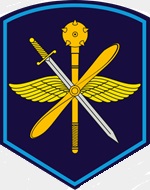Hobby Master HA9705 Russian Mikoyan Gurevich MiG 31K "Foxhound-D" Interceptor with KH-47M2 "Kinzhal" Hypersonic Missile - "Blue 36", Russian Long Range Aviation Command, Russia, 2024 (1:72 Scale) "We are planning to use MiG-31 high-altitude interceptors for protecting Russia's sovereign airspace in the northern directions and there we are limited to airports and airfields, which are very few in that region."
- Russian Major-General Vladimir Popov
 The Mikoyan MiG-31 (NATO reporting name: Foxhound) is a supersonic interceptor aircraft that was developed for use by the Soviet Air Forces. The aircraft was designed by the Mikoyan design bureau as a replacement for the earlier MiG-25 "Foxbat"; the MiG-31 is based on and shares design elements with the MiG-25. The MiG-31 is among the fastest combat jets in the world. It continues to be operated by the Russian Air Force and the Kazakh Air Force following the end of the Cold War and the collapse of the Soviet Union in 1991. The Russian Defence Ministry expects the MiG-31 to remain in service until 2030 or beyond; that was confirmed in 2020 when an announcement was made to extend the service lifetime from 2,500 to 3,500 hours on the existing air frames.
The Mikoyan MiG-31 (NATO reporting name: Foxhound) is a supersonic interceptor aircraft that was developed for use by the Soviet Air Forces. The aircraft was designed by the Mikoyan design bureau as a replacement for the earlier MiG-25 "Foxbat"; the MiG-31 is based on and shares design elements with the MiG-25. The MiG-31 is among the fastest combat jets in the world. It continues to be operated by the Russian Air Force and the Kazakh Air Force following the end of the Cold War and the collapse of the Soviet Union in 1991. The Russian Defence Ministry expects the MiG-31 to remain in service until 2030 or beyond; that was confirmed in 2020 when an announcement was made to extend the service lifetime from 2,500 to 3,500 hours on the existing air frames.
The single-seat MiG-25 could achieve high speed, altitude and rate of climb; however, it lacked maneuverability at interception speeds and was difficult to fly at low altitudes. The MiG-25's speed was normally limited to Mach 2.83, but it could reach a maximum speed of Mach 3.2 or more with the risk of engine damage.
Development of the MiG-25's replacement began with the Ye-155MP prototype which first flew on 16 September 1975. Although it bore a superficial resemblance to the MiG-25, it had a longer fuselage to accommodate the radar operator's cockpit and was in many respects a new design. An important development was the MiG-31's advanced radar, capable of both look-up and look-down/shoot-down engagement, as well as multiple target tracking. This gave the Soviet Union an interceptor with the capability to engage the most likely Western intruders (low-flying cruise missiles and bombers) at long range. The MiG-31 replaced the Tu-128 as the Soviet Union's dedicated long-range interceptor, with far more advanced sensors and weapons, while its range is almost double that of the MiG-25.
Like that of its MiG-25 predecessor, the introduction of the MiG-31 was surrounded by early speculation and misinformation concerning its design and abilities. The West learned of the new interceptor from Lieutenant Viktor Belenko, a pilot who defected to Japan in 1976 with his MiG-25P. Belenko described an upcoming "Super Foxbat" with two seats and an ability to intercept cruise missiles. According to his testimony, the new interceptor was to have air intakes similar to the Mikoyan-Gurevich MiG-23, which the MiG-31 does not have, at least in production variants.
Pictured here is a 1:72 scale replica of a Russian Mikoyan Gurevich MiG 31K "Foxhound-D" Interceptor carrying a KH-47M2 "Kinzhal" hypersonic missile that was attached to the Russian Long Range Aviation Command. Now in stock!
Dimensions:
Wingspan: 7-1/4-inches
Length: 12-1/2-inches
Release Date: October 2024
 Historical Account: "Long Distance Run Around" - Long-Range Aviation (Aviatsiya dal'nego deystviya, literally Aviation of Distant Action and abbreviated DA) is a sub-branch of the Russian Aerospace Forces responsible for delivering long-range nuclear or conventional strikes by aircraft (rather than missiles). The branch was previously part of the Soviet Air Forces and Russian Air Force tasked with long-range bombardment of strategic targets with nuclear weapons.
Historical Account: "Long Distance Run Around" - Long-Range Aviation (Aviatsiya dal'nego deystviya, literally Aviation of Distant Action and abbreviated DA) is a sub-branch of the Russian Aerospace Forces responsible for delivering long-range nuclear or conventional strikes by aircraft (rather than missiles). The branch was previously part of the Soviet Air Forces and Russian Air Force tasked with long-range bombardment of strategic targets with nuclear weapons.
During the Cold War, the Long-Range Aviation of the Air Forces (DA VS) was the rough Soviet equivalent to the French Air Force's Forces aeriennes strategiques (1964-present); the British RAF Bomber Command (1936-68); and the United States Air Force (USAF) Strategic Air Command (1946-1992). In the early 2020s there are roughly-equivalent structures within the People's Liberation Army Air Force and in the USAF Air Force Global Strike Command.
Long-Range Aviation traces its history to the Aviation of Distant Action, or ADD, and the 18th Air Army of the Second World War and beforehand. This article sketches the development of Soviet and Russian long-range bomber forces from their origins in the mid-1930s.


